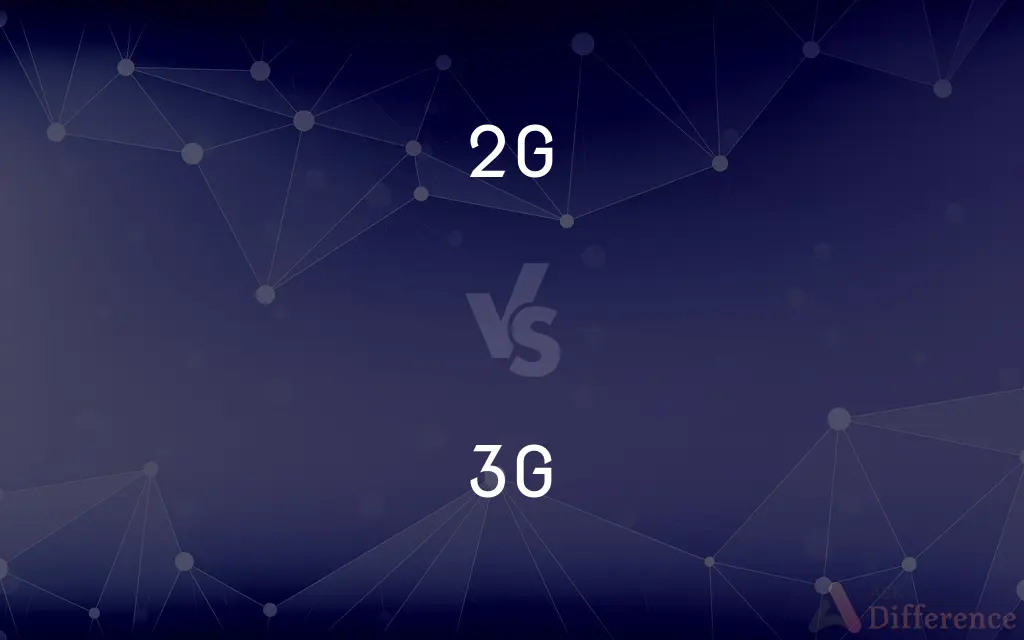2G vs. 3G — What's the Difference?
By Tayyaba Rehman & Maham Liaqat — Published on May 30, 2024
2G focuses on voice communication and SMS, while 3G enhances mobile internet experience with faster data speeds.

Difference Between 2G and 3G
Table of Contents
ADVERTISEMENT
Key Differences
2G, or second-generation wireless telephone technology, revolutionized mobile communications by introducing digital systems, improving security and capacity over its analog predecessor. It primarily supports voice calls and SMS, with data speeds up to 64 kbps. Whereas 3G, or third-generation technology, was developed to provide faster data transmission rates, enabling mobile internet, video calls, and multimedia services, with speeds ranging from 384 kbps to several Mbps.
While 2G networks use TDMA or CDMA for channel access, ensuring efficient and secure voice and SMS services, 3G networks leverage WCDMA, HSPA, or CDMA2000 technologies to offer enhanced bandwidth and support for a wider range of applications, including high-speed internet and video streaming.
2G's efficiency in voice transmission and low power consumption made it ideal for voice-centric users and IoT devices requiring minimal data exchange. On the other hand, 3G's higher data rates and capacity cater to the growing demand for mobile internet access and multimedia services, bridging the gap between mobile phones and computers.
2G's infrastructure is widely regarded as more cost-effective and simpler to maintain, making it prevalent in rural or remote areas. In contrast, 3G networks require more complex infrastructure and higher investment but deliver significantly improved user experiences through faster data speeds and better quality of service.
Despite 2G's continued relevance in certain applications, the advent of 3G marked a significant shift towards mobile internet and multimedia usage, setting the stage for the development of even faster technologies like 4G and 5G, which further transform how we access and share information.
ADVERTISEMENT
Comparison Chart
Introduction Year
Early 1990s
Early 2000s
Data Speed
Up to 64 kbps
384 kbps to several Mbps
Technology
TDMA, CDMA
WCDMA, HSPA, CDMA2000
Main Services
Voice calls, SMS
Mobile internet, video calls, multimedia services
Power Consumption
Lower
Higher due to more data transmission
Compare with Definitions
2G
Low Data Rate
2G supports basic internet services with limited speed and efficiency.
3G
Global Roaming
3G facilitates improved global roaming capabilities for users traveling abroad.
2G
Digital Cellular Technology
2G introduced digital encryption, enhancing security for voice and SMS services.
3G
Multimedia Services
3G enables streaming of audio and video, enriching media consumption.
2G
Voice and SMS Focused
2G excels in providing efficient voice and text messaging services.
3G
Enhanced Mobile Communications
3G networks support high-speed internet and video calling.
2G
GSM Standard
2G networks primarily use GSM, facilitating global mobile communication.
3G
Increased Bandwidth
3G's higher bandwidth supports advanced applications and services.
2G
Energy Efficient
2G devices have longer battery life due to lower power consumption.
3G
Broadband Speeds
3G provides faster data rates, improving mobile web browsing experiences.
Common Curiosities
What distinguishes 2G from 3G technology?
2G focuses on voice and SMS, while 3G introduces faster data speeds and supports mobile internet and multimedia services.
Can 2G phones work on 3G networks?
Generally, no, because 2G phones lack the necessary hardware to connect to 3G networks.
Is 3G faster than 2G?
Yes, 3G provides significantly faster data transmission speeds compared to 2G.
How does 2G technology work?
2G networks use digital signals for voice communication and SMS, employing TDMA or CDMA for channel access.
Why is 2G still used?
2G remains in use for voice services, low-data IoT devices, and in regions with limited 3G/4G coverage.
What is the impact of 3G on mobile communications?
3G significantly enhanced mobile internet access, making smartphones and data-driven services more prevalent.
What are the main benefits of 3G over 2G?
3G offers higher data speeds, better quality of service, and supports a wider range of multimedia applications.
Do 2G and 3G use the same frequency bands?
They can share frequency bands, but the technologies and data capacity capabilities are different.
What technology underpins 3G?
3G uses technologies like WCDMA, HSPA, or CDMA2000 to enhance data transmission rates and bandwidth.
Can I use 3G for voice calls and SMS?
Yes, 3G supports all functionalities of 2G, including voice calls and SMS, with improved quality.
Why is 3G considered better for internet use?
Due to its higher data speeds and capacity, 3G greatly improves mobile internet access and multimedia services.
Are 2G and 3G compatible?
Devices and networks can be designed for backward compatibility, allowing 3G devices to use 2G networks.
How do data rates compare between 2G and 3G?
3G offers data rates hundreds of times faster than 2G, facilitating a broad range of internet services.
What happens to 2G networks as 3G becomes more prevalent?
Some 2G networks are being phased out, but they remain operational for specific uses and in certain areas.
What's the future of 2G and 3G networks?
While newer technologies like 4G and 5G are becoming dominant, 2G and 3G still serve critical roles in global telecommunications.
Share Your Discovery

Previous Comparison
Chai vs. Dirty Chai
Next Comparison
Accomplishment vs. AwardAuthor Spotlight
Written by
Tayyaba RehmanTayyaba Rehman is a distinguished writer, currently serving as a primary contributor to askdifference.com. As a researcher in semantics and etymology, Tayyaba's passion for the complexity of languages and their distinctions has found a perfect home on the platform. Tayyaba delves into the intricacies of language, distinguishing between commonly confused words and phrases, thereby providing clarity for readers worldwide.
Co-written by
Maham Liaqat













































